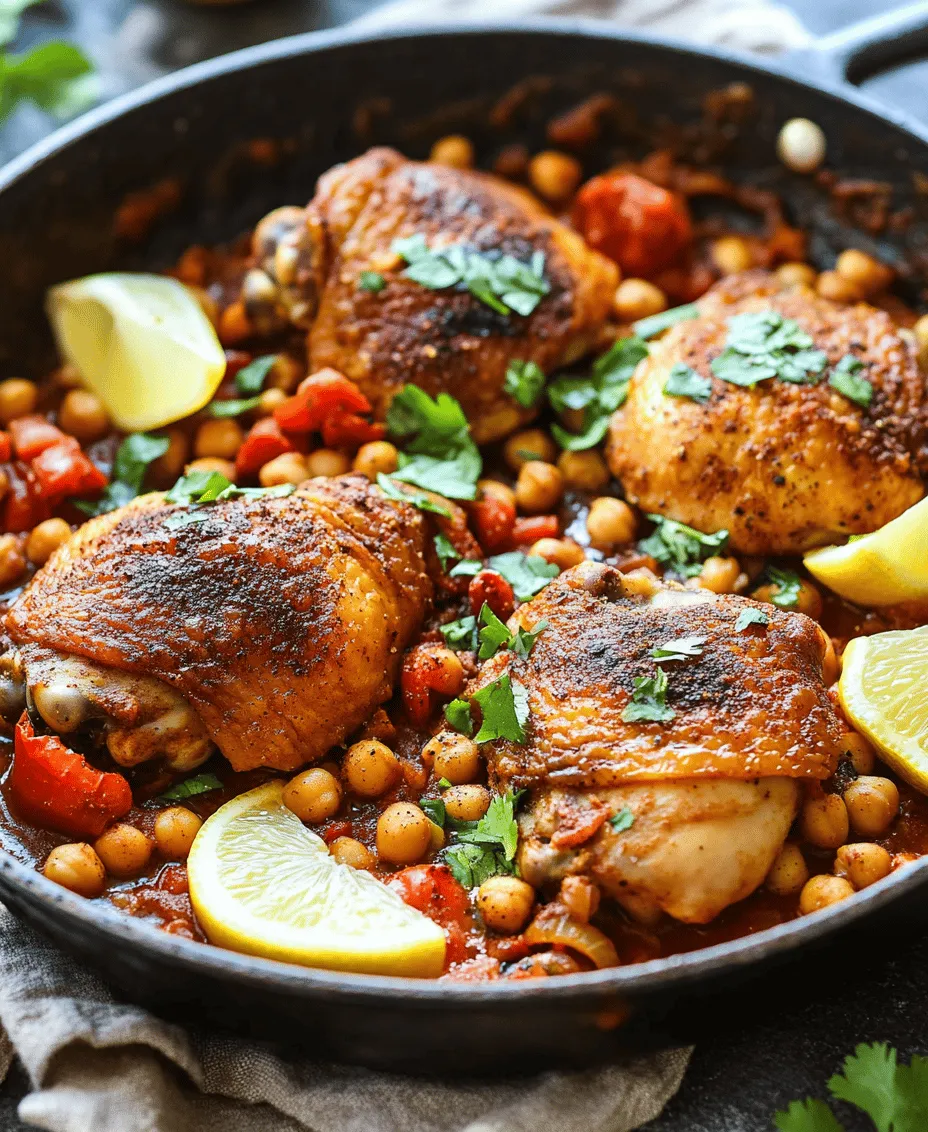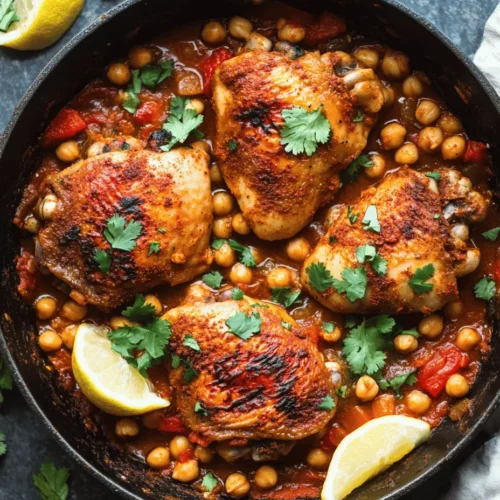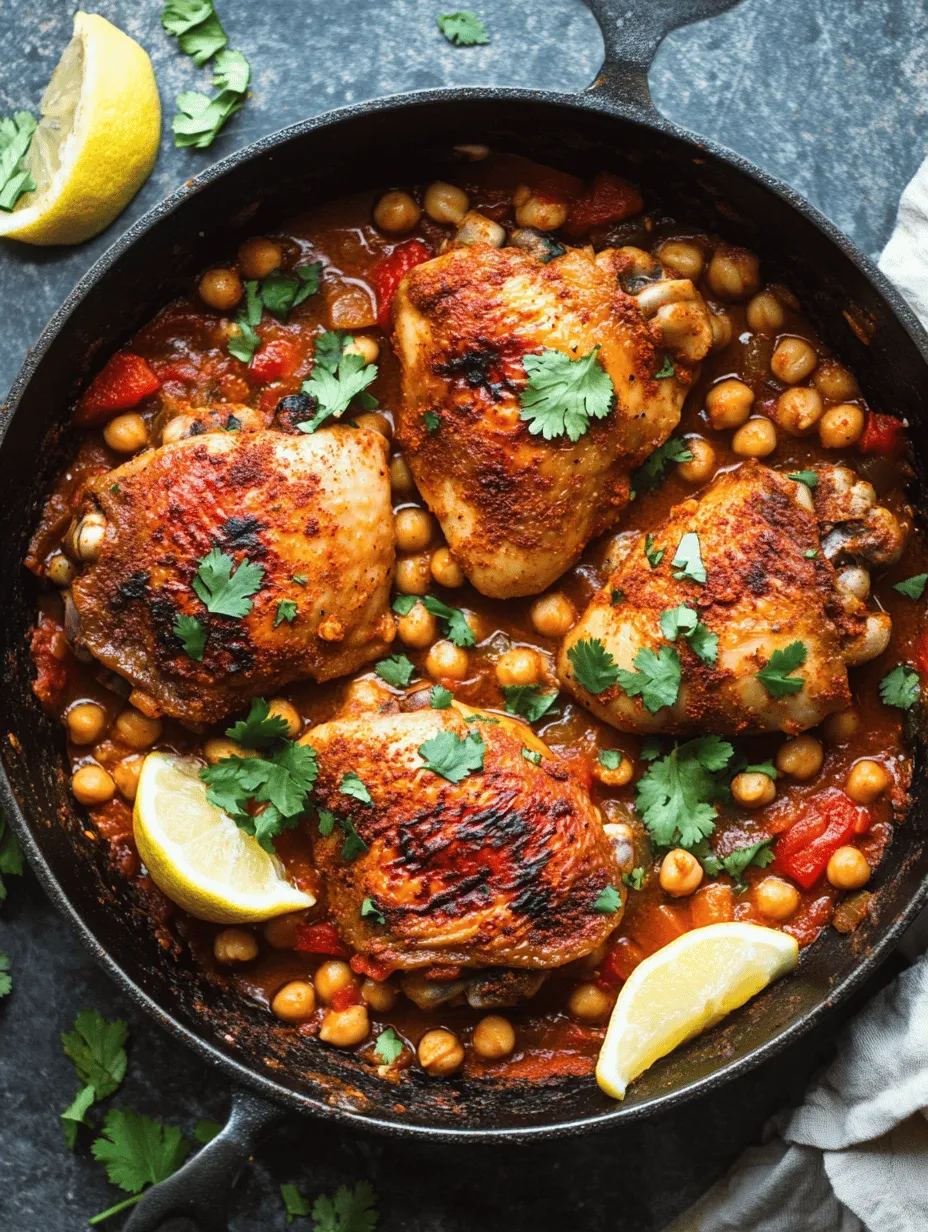Exploring the vibrant and aromatic world of Moroccan cuisine can be a delightful culinary journey. One standout dish that embodies the rich flavors of this North African tradition is Moroccan Spiced Chicken. This recipe combines succulent chicken thighs with a blend of warm spices, chickpeas, and tomatoes, creating a dish that is both comforting and exotic. In this article, we will delve into the details of preparing this delicious dish, exploring its ingredients, cooking techniques, and cultural significance, while also providing insights that will enhance your cooking experience.
Understanding Moroccan Cuisine
Defining Moroccan Culinary Traditions
Moroccan cuisine is a tapestry of flavors, colors, and aromas that reflect the country’s diverse cultural influences, including Berber, Arab, and Mediterranean traditions. At the heart of Moroccan cooking lies a deep respect for fresh ingredients and time-honored techniques. Meals are often family-oriented, served in communal settings, and typically comprise multiple courses. The cuisine is characterized by its use of spices, which are integral to the flavors of Moroccan dishes.
Tagines, the signature earthenware cooking vessel, are commonly used to slow-cook stews, allowing flavors to meld beautifully over time. Moroccan meals are often accompanied by bread, which acts as both a utensil and a staple. The cultural significance of these meals goes beyond mere sustenance; they are occasions for gathering and celebrating, illustrating the importance of hospitality in Moroccan society.
Exploring the Influence of Spices in Moroccan Cooking
Spices are the soul of Moroccan cuisine, providing depth, warmth, and complexity to dishes. A typical Moroccan spice blend, known as “ras el hanout,” can contain up to 30 different spices, including cumin, coriander, cinnamon, and paprika. This aromatic mixture varies from region to region and even from household to household, showcasing the individuality of each cook.
The use of spices not only enhances the flavor of the dishes but also contributes to their health benefits. For instance, cumin is known for its digestive properties, while cinnamon is revered for its anti-inflammatory effects. The careful selection and combination of spices in Moroccan cooking create a symphony of flavors that can transport you to the bustling markets of Marrakech or the serene landscapes of the Atlas Mountains.
The Role of Chicken in Moroccan Dishes
Chicken is a staple ingredient in Moroccan cuisine, valued for its versatility and ability to absorb flavors. It is often featured in tagines, couscous, and stews, making it a beloved choice for both everyday meals and special occasions. The most popular cuts used in Moroccan chicken dishes are thighs and drumsticks, which remain tender and juicy during cooking.
In Moroccan homes, chicken is not just a protein source; it symbolizes warmth and hospitality. Preparing a chicken dish often signifies a gathering, whether it’s a family dinner or a celebration with friends. The act of sharing a meal, especially one that features chicken, is deeply rooted in Moroccan culture and reflects the warmth of Moroccan hospitality.
Ingredients Overview
Essential Ingredients for Moroccan Spiced Chicken
To prepare Moroccan Spiced Chicken, you will need a selection of fresh ingredients that work harmoniously together to create a flavorful dish. Here are the essential components:
– Chicken Thighs: This cut is preferred for its rich flavor and tenderness, making it ideal for slow-cooking methods.
– Chickpeas: A great source of protein and fiber, chickpeas add heartiness to the dish.
– Tomatoes: Fresh or canned tomatoes provide acidity, which balances the richness of the chicken and spices.
– Onion: Onions form the aromatic base of the dish, enhancing its overall flavor.
– Garlic: Fresh garlic adds depth and a pungent note that compliments the spices.
– Spices: A mixture of cumin, coriander, cinnamon, paprika, and turmeric creates the signature Moroccan flavor profile.
– Fresh Herbs: Parsley and cilantro are commonly used to garnish the dish, adding a fresh and vibrant touch.
Understanding the Role of Each Spice
Each spice in the Moroccan Spiced Chicken recipe plays a crucial role in building the dish’s flavor profile.
– Cumin: Earthy and warm, cumin enhances the chicken’s natural flavors while adding a hint of nuttiness.
– Coriander: Fresh and citrusy, coriander complements the richness of the chicken and the sweetness of the tomatoes.
– Cinnamon: This warm spice adds a subtle sweetness that balances the savory elements.
– Paprika: Both sweet and smoky varieties can be used to impart a rich color and enhance the dish’s overall flavor.
– Turmeric: Known for its vibrant color and health benefits, turmeric adds earthiness and depth.
The Importance of Fresh Herbs and Aromatics
Fresh herbs and aromatics are key to achieving the authentic taste of Moroccan cuisine. They not only enhance the flavor but also add brightness and freshness to the dish. The combination of parsley and cilantro used as a garnish provides a lovely color contrast and a refreshing finish.
Using fresh herbs is essential for maximizing flavor; dried herbs, while convenient, can lack the vibrancy and depth that fresh herbs provide. Incorporating fresh garlic and onions at the beginning of the cooking process builds a flavorful base, creating layers of taste that will elevate your Moroccan Spiced Chicken.
Preparation Steps
Step-by-Step Guide to Preparing Moroccan Spiced Chicken
Now that we have a solid understanding of the ingredients and the cultural significance of Moroccan Spiced Chicken, let’s dive into the preparation steps. This comprehensive guide will help you navigate the cooking process with ease, ensuring you achieve a delicious and aromatic result.
Preparing the Chicken: Tips for Best Results
Start by selecting high-quality chicken thighs, preferably bone-in and skin-on for maximum flavor. Rinse the chicken under cold water and pat it dry with paper towels. This step is crucial for achieving a nice sear later on. If you prefer a lighter dish, you can remove the skin, but keep in mind that it adds richness and flavor.
Next, season the chicken generously with salt and pepper. This foundational seasoning is essential to enhance the overall taste of the dish. Allow the chicken to marinate for at least 30 minutes—if time permits, marinating it for several hours or overnight will yield an even deeper flavor.
Creating the Spice Mixture: Balancing Flavors
While the chicken marinates, prepare the spice mixture. In a small bowl, combine the cumin, coriander, cinnamon, paprika, and turmeric. Adjust the quantities based on your taste preferences; for a spicier kick, consider adding cayenne pepper or chili powder.
Mix the spices thoroughly to ensure an even distribution of flavors. This spice blend will be used to season the chicken before cooking and will also be added to the sauce later on, infusing the entire dish with aromatic goodness.
Searing the Chicken: Techniques for Perfect Browning
Once the chicken is marinated and your spice mixture is ready, it’s time to sear the chicken. Heat a large, heavy-bottomed skillet or Dutch oven over medium-high heat and add a couple of tablespoons of olive oil.
When the oil is shimmering, carefully add the chicken pieces, skin side down. Avoid overcrowding the pan; if necessary, sear the chicken in batches. The goal is to achieve a golden-brown crust, which will add depth of flavor to the dish. Sear each side for about 5-7 minutes, or until browned, then transfer the chicken to a plate and set it aside.
Sautéing Aromatics: Building Flavor Foundations
In the same pan, reduce the heat to medium and add chopped onions. Sauté the onions, stirring occasionally, until they are translucent and beginning to caramelize, about 5-6 minutes. This step is crucial for building the flavor base of your Moroccan Spiced Chicken.
Next, add minced garlic and sauté for an additional minute until fragrant. Be careful not to burn the garlic, as it can turn bitter. Once the onions and garlic are perfectly sautéed, it’s time to add the spice mixture. Stir the spices into the aromatics, allowing them to toast slightly for about 1-2 minutes. This technique will release the essential oils in the spices, enhancing their flavor and aroma.
Combining Ingredients: The Importance of Proper Order
With the aromatics and spices ready, it’s time to combine the remaining ingredients. Begin by adding the canned or fresh tomatoes to the pan, followed by drained chickpeas. Stir to combine everything thoroughly, ensuring the spices coat the vegetables and chickpeas.
Return the seared chicken to the pan, nestling it among the sauce. Pour in enough chicken broth or water to cover the chicken halfway. This liquid will not only help in cooking the chicken but also create a flavorful sauce.
Bring the mixture to a simmer, cover the pan, and reduce the heat to low. Allow the dish to cook gently for about 30-40 minutes, or until the chicken is tender and fully cooked through. During this time, the flavors will meld beautifully, resulting in a rich and aromatic sauce that pairs perfectly with the chicken.
As you embark on this culinary adventure, remember to enjoy the process and savor the enticing aromas filling your kitchen. The journey of preparing Moroccan Spiced Chicken is as rewarding as the final dish itself, promising a delightful experience that you and your loved ones will cherish.
Stay tuned for the next part of this article, where we will explore tips for achieving the best results with your Moroccan Spiced Chicken, as well as answer some common questions about this beloved dish.

Cooking Process
Simmering: The Key to Tender Chicken
To ensure your Moroccan Spiced Chicken is tender and full of flavor, simmering is an essential step. After browning the chicken pieces in a hot skillet, reduce the heat and add your aromatic mixture of spices, garlic, and onion. Pour in the chicken broth or water, allowing the liquid to come to a gentle simmer. This slow cooking method allows the spices to infuse deep into the chicken, transforming it into a succulent masterpiece.
It is crucial to cover the pot while simmering to trap the steam, which helps keep the chicken moist. Depending on the size of your chicken pieces, simmer for about 30 to 45 minutes. If you’re using boneless, skinless chicken thighs or breasts, the cooking time may be shorter, around 20 to 30 minutes. Always check for doneness using a meat thermometer; chicken should reach an internal temperature of 165°F (75°C) for safe consumption.
Adjusting Cooking Times for Different Cuts of Chicken
When preparing Moroccan Spiced Chicken, the cut of chicken you choose will significantly affect the cooking time. Bone-in chicken thighs and drumsticks typically require longer cooking times than boneless cuts. For bone-in pieces, aim for 40 to 50 minutes of simmering, whereas boneless chicken thighs may only take 25 to 30 minutes.
If you choose to use chicken breasts, consider cutting them into smaller pieces to ensure even cooking and to speed up the process. Additionally, keep in mind that the larger the chicken pieces, the longer they will take to cook through. Always prioritize checking the internal temperature to guarantee that your chicken is cooked safely and thoroughly.
Understanding Temperature: Ensuring Safe Cooking
Ensuring your chicken is cooked to the proper temperature is vital not only for food safety but also for achieving the desired texture. Using a meat thermometer is the best way to confirm doneness; insert the thermometer into the thickest part of the chicken, avoiding any bones. As mentioned earlier, the USDA recommends that chicken should reach an internal temperature of at least 165°F (75°C).
If you find that your chicken is cooking unevenly, you may want to adjust the heat. A gentle simmer is ideal since it helps to break down the chicken fibers without drying them out. If you’re unsure about the doneness, let the chicken rest for a few minutes after cooking, as it will continue to cook slightly from residual heat.
Serving Suggestions
Garnishing Your Dish: The Final Touches
Presentation is key when serving Moroccan Spiced Chicken. Once cooked, consider garnishing your dish with fresh herbs to enhance both flavor and visual appeal. A sprinkle of chopped fresh cilantro or parsley adds a burst of color and freshness that complements the rich spices. You can also add toasted slivered almonds or pine nuts for a delightful crunch.
For an extra touch of authenticity, consider placing lemon wedges on the side. The acidity of the lemon juice brightens the dish, balancing the warm spices beautifully. Serve your Moroccan Spiced Chicken in a large, colorful serving dish, making it the centerpiece of your meal.
Pairing Moroccan Spiced Chicken with Side Dishes
To create a well-rounded meal, pair your Moroccan Spiced Chicken with complementary side dishes. Traditional sides such as fluffy couscous or fragrant rice work beautifully with the chicken, allowing the spices and sauce to be absorbed. You may also want to consider serving a simple salad, such as a cucumber and tomato salad drizzled with olive oil and lemon juice, which adds a refreshing contrast to the spiced flavors.
Another popular option is roasted vegetables, such as zucchini, bell peppers, or carrots, seasoned with Moroccan spices. These add color and nutrition to your plate while enhancing the overall meal experience.
Exploring Traditional Accompaniments: Couscous and Flatbreads
Couscous is a staple in Moroccan cuisine, offering a perfect base for your Spiced Chicken. Made from semolina wheat, couscous cooks quickly and pairs well with the rich sauce of the chicken. For an even more flavorful dish, consider cooking the couscous in the leftover chicken broth instead of water, allowing it to absorb all the aromatic flavors.
Flatbreads, such as Moroccan khobz, are also a delightful accompaniment. They can be used to scoop up the chicken and sauce or served alongside to soak up the delicious flavors. Warm the flatbreads before serving for an inviting touch.
Cultural Significance of Moroccan Spiced Chicken
The Role of Chicken in Moroccan Family Meals
In Moroccan culture, chicken holds a special place in family meals and gatherings. It is often prepared for celebrations, family feasts, and special occasions, symbolizing hospitality and abundance. The communal nature of Moroccan dining encourages sharing, and dishes like Moroccan Spiced Chicken are typically served in large platters for everyone to enjoy together.
The act of gathering around a meal fosters connection and strengthens family bonds. The vibrant spices and flavors found in Moroccan cuisine reflect the country’s rich history and cultural diversity, making each meal an opportunity to celebrate heritage and tradition.
Celebrating Moroccan Heritage Through Food
Moroccan Spiced Chicken is not just a dish; it is a representation of the country’s culinary heritage. The use of spices like cumin, coriander, and saffron showcases the country’s history as a crossroads of trade, where diverse influences from Africa, the Middle East, and Europe have merged. Each ingredient tells a story, allowing those who prepare and share the dish to connect with Moroccan culture.
Cooking and sharing this meal brings communities together, encouraging the sharing of traditions and recipes across generations. By preparing Moroccan Spiced Chicken, you are not just nourishing your body; you are participating in a rich tapestry of culture and history.
How Moroccan Spiced Chicken is Served on Special Occasions
During special occasions, Moroccan Spiced Chicken is often featured prominently on the table. Whether it’s a wedding, holiday feast, or a family gathering, this dish embodies celebration and joy. It is typically served with a variety of side dishes, allowing guests to create their own plates filled with flavors and textures.
Traditionally, chicken is sometimes cooked in a tagine, a clay pot designed for slow cooking, which enhances the dish’s flavor and tenderness. The presentation of the dish is equally important; it is common to decorate the table with vibrant tableware, creating an inviting atmosphere for guests.
Nutritional Benefits
Analyzing the Nutritional Profile of Moroccan Spiced Chicken
Moroccan Spiced Chicken is not only delicious but also offers several nutritional benefits. Chicken is an excellent source of lean protein, which is essential for muscle growth and repair. It provides essential amino acids necessary for overall health. When prepared with a variety of spices and vegetables, this dish also becomes rich in vitamins and minerals.
The addition of chickpeas in some variations of the recipe boosts the fiber content, promoting digestive health and providing a satisfying fullness. Moreover, spices such as turmeric and cumin are known for their anti-inflammatory properties, adding another layer of nutritional value to your meal.
Health Benefits of Key Ingredients: Chicken, Chickpeas, and Spices
The main ingredients in Moroccan Spiced Chicken contribute to a well-balanced meal. Chicken provides protein, while chickpeas offer plant-based protein along with fiber, which is beneficial for heart health and weight management.
The spices used in this recipe, such as cinnamon, ginger, and garlic, not only enhance the flavor but also come with various health benefits. For instance, ginger is known for its anti-nausea properties, and garlic has been linked to improved heart health. Including these ingredients in your cooking not only elevates the taste of your dishes but also supports your overall well-being.
Balancing Flavor and Nutrition: Making Healthier Choices
To make your Moroccan Spiced Chicken even healthier, consider using skinless chicken and reducing the amount of added fats like oil. You can also increase the vegetable content by adding more carrots, peppers, or green beans to the dish, enhancing both flavor and nutrition.
Additionally, enjoy the dish in moderation, pairing it with whole grains like brown rice or whole wheat couscous. This ensures that you are not only indulging in a tasty dish but also making choices that align with a balanced diet.
Conclusion
Moroccan Spiced Chicken is not just a meal; it’s a celebration of flavors, traditions, and culture. By mastering this recipe, you not only create a delicious dish but also gain insight into the culinary practices that define Moroccan cuisine. Whether served for a family gathering or a special occasion, this dish promises to impress and satisfy, showcasing the beauty of cooking with spices and fresh ingredients.
Embrace the journey of cooking Moroccan Spiced Chicken, and enjoy the rich tapestry of flavors it brings to your table. Each bite is a taste of Morocco, filled with history, warmth, and the joy of sharing good food with loved ones.



